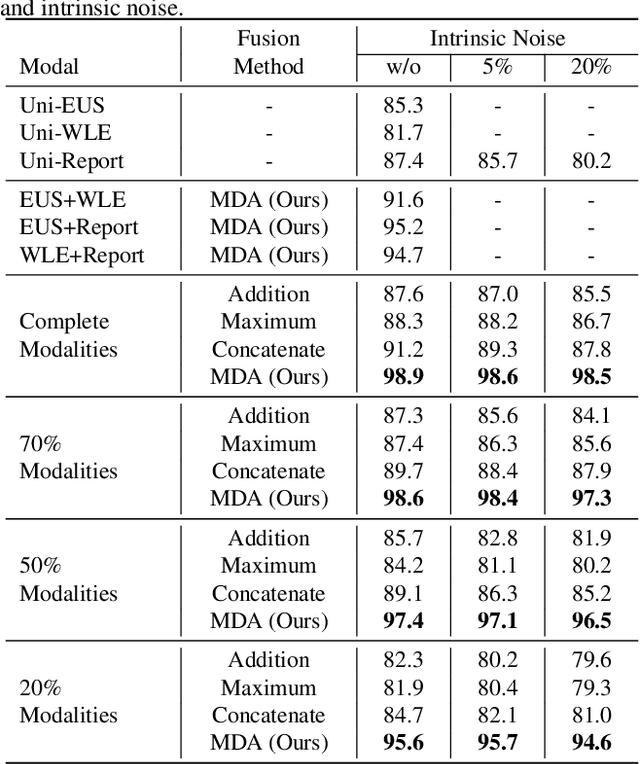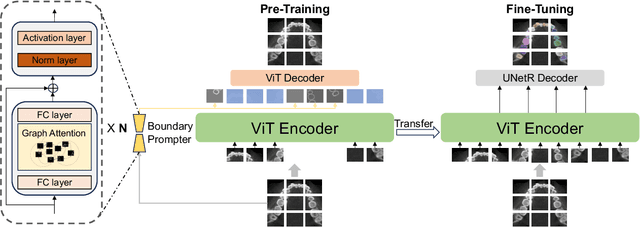Pengyu Dai
Layer Separation: Adjustable Joint Space Width Images Synthesis in Conventional Radiography
Feb 04, 2025Abstract:Rheumatoid arthritis (RA) is a chronic autoimmune disease characterized by joint inflammation and progressive structural damage. Joint space width (JSW) is a critical indicator in conventional radiography for evaluating disease progression, which has become a prominent research topic in computer-aided diagnostic (CAD) systems. However, deep learning-based radiological CAD systems for JSW analysis face significant challenges in data quality, including data imbalance, limited variety, and annotation difficulties. This work introduced a challenging image synthesis scenario and proposed Layer Separation Networks (LSN) to accurately separate the soft tissue layer, the upper bone layer, and the lower bone layer in conventional radiographs of finger joints. Using these layers, the adjustable JSW images can be synthesized to address data quality challenges and achieve ground truth (GT) generation. Experimental results demonstrated that LSN-based synthetic images closely resemble real radiographs, and significantly enhanced the performance in downstream tasks. The code and dataset will be available.
BLS-GAN: A Deep Layer Separation Framework for Eliminating Bone Overlap in Conventional Radiographs
Sep 11, 2024Abstract:Conventional radiography is the widely used imaging technology in diagnosing, monitoring, and prognosticating musculoskeletal (MSK) diseases because of its easy availability, versatility, and cost-effectiveness. In conventional radiographs, bone overlaps are prevalent, and can impede the accurate assessment of bone characteristics by radiologists or algorithms, posing significant challenges to conventional and computer-aided diagnoses. This work initiated the study of a challenging scenario - bone layer separation in conventional radiographs, in which separate overlapped bone regions enable the independent assessment of the bone characteristics of each bone layer and lay the groundwork for MSK disease diagnosis and its automation. This work proposed a Bone Layer Separation GAN (BLS-GAN) framework that can produce high-quality bone layer images with reasonable bone characteristics and texture. This framework introduced a reconstructor based on conventional radiography imaging principles, which achieved efficient reconstruction and mitigates the recurrent calculations and training instability issues caused by soft tissue in the overlapped regions. Additionally, pre-training with synthetic images was implemented to enhance the stability of both the training process and the results. The generated images passed the visual Turing test, and improved performance in downstream tasks. This work affirms the feasibility of extracting bone layer images from conventional radiographs, which holds promise for leveraging bone layer separation technology to facilitate more comprehensive analytical research in MSK diagnosis, monitoring, and prognosis. Code and dataset will be made available.
MDA: An Interpretable Multi-Modal Fusion with Missing Modalities and Intrinsic Noise
Jun 15, 2024



Abstract:Multi-modal fusion is crucial in medical data research, enabling a comprehensive understanding of diseases and improving diagnostic performance by combining diverse modalities. However, multi-modal fusion faces challenges, including capturing interactions between modalities, addressing missing modalities, handling erroneous modal information, and ensuring interpretability. Many existing researchers tend to design different solutions for these problems, often overlooking the commonalities among them. This paper proposes a novel multi-modal fusion framework that achieves adaptive adjustment over the weights of each modality by introducing the Modal-Domain Attention (MDA). It aims to facilitate the fusion of multi-modal information while allowing for the inclusion of missing modalities or intrinsic noise, thereby enhancing the representation of multi-modal data. We provide visualizations of accuracy changes and MDA weights by observing the process of modal fusion, offering a comprehensive analysis of its interpretability. Extensive experiments on various gastrointestinal disease benchmarks, the proposed MDA maintains high accuracy even in the presence of missing modalities and intrinsic noise. One thing worth mentioning is that the visualization of MDA is highly consistent with the conclusions of existing clinical studies on the dependence of different diseases on various modalities. Code and dataset will be made available.
Sparse Anatomical Prompt Semi-Supervised Learning with Masked Image Modeling for CBCT Tooth Segmentation
Feb 07, 2024


Abstract:Accurate tooth identification and segmentation in Cone Beam Computed Tomography (CBCT) dental images can significantly enhance the efficiency and precision of manual diagnoses performed by dentists. However, existing segmentation methods are mainly developed based on large data volumes training, on which their annotations are extremely time-consuming. Meanwhile, the teeth of each class in CBCT dental images being closely positioned, coupled with subtle inter-class differences, gives rise to the challenge of indistinct boundaries when training model with limited data. To address these challenges, this study aims to propose a tasked-oriented Masked Auto-Encoder paradigm to effectively utilize large amounts of unlabeled data to achieve accurate tooth segmentation with limited labeled data. Specifically, we first construct a self-supervised pre-training framework of masked auto encoder to efficiently utilize unlabeled data to enhance the network performance. Subsequently, we introduce a sparse masked prompt mechanism based on graph attention to incorporate boundary information of the teeth, aiding the network in learning the anatomical structural features of teeth. To the best of our knowledge, we are pioneering the integration of the mask pre-training paradigm into the CBCT tooth segmentation task. Extensive experiments demonstrate both the feasibility of our proposed method and the potential of the boundary prompt mechanism.
 Add to Chrome
Add to Chrome Add to Firefox
Add to Firefox Add to Edge
Add to Edge